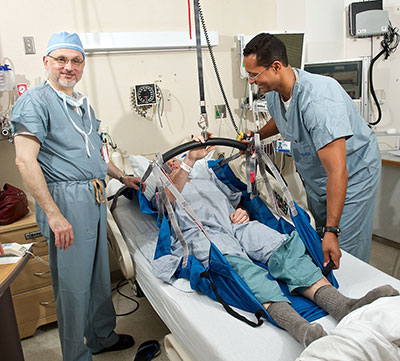Safe Patient Mobilization Initiative to Roll Out this Fall

Raphael Bueno, MD, at left, and Ruben Santana, RN, at right, prepare to use the ceiling lift for patient Ken Rogers on Tower 11. |
As a nurse practitioner in Occupational Health, Carin Bennett-Rizzo, NP, often treats nurses, patient care assistants and other employees with work-related injuries.
"I've been in Occupational Health for four years, and I've seen many back and shoulder injuries related to lifting and manually moving patients," she said.
Bennett-Rizzo understands the physical demands of bedside nursing-she was a staff nurse for eight years at BWH, working in the Float Pool and Cardiology.
"Before an employee returns to work after their injury, I tell them about the equipment that's available to protect them," she said. "Ceiling lifts work when you are boosting a patient, but there is also other equipment, like walkers with seats and stand-assist devices, that help to support patients in ambulating around the unit or helping them to get up from a chair."
A new safe patient mobilization program that provides education about using equipment to move patients is rolling out in the Department of Nursing and Patient Care Services this fall. The initiative, called "Making the Right Moves: Healthy for Our Patients/Safe for Our Staff," involves using equipment to mobilize patients, rather than lifting them manually, regularly assessing patient functional mobility status and documenting patient mobility status and strategies used to mobilize patients.
The program provides nurses with appropriate strategies for assessment of patient functional mobility and matching a patient's functional mobility status with the appropriate device or intervention, which can help to keep patients safe and prevent falls and pressure ulcers.
"We know that early, safe and frequent mobilization facilitates patient recovery and improve outcomes. The program also benefits staff," said Tucker O'Day, MSPT, MS, program manager of Occupational Health, who is leading the initiative with Deb Mulloy, PhD, RN, executive director for Nursing Quality, Measurement and Improvement, and Kevin Hulme, nursing finance manager. "Manual movement of patients contributes to the majority of injuries we see among our nursing staff. Moving patients with equipment, and clearly assessing their mobility needs before moving them, helps protect them-and us-from injury."
Elizabeth Taylor, RN, hopes that nurses and patient care assistants will take advantage of the equipment and incorporate it into their daily practice.
"In the ICU, our staff take care of the sickest patients, many of whom can't move on their own," said Taylor, who previously worked in the Cardiac Surgery ICU. "They also have a lot of heavy equipment, like VADs and dialysis machines. Using the ceiling lifts and other equipment for routine boosting and moving can really reduce the strain on nurses."
Although Taylor loved caring for cardiac surgery patients, she eventually had to leave the unit due to a back injury.
"No one is invincible," said Taylor, who now works in the Electrophysiology Lab. "As nurses, we always put our patients first, but if we don't protect ourselves, who will be at the bedside to take care of us and our families?"
An Introductory Learning Module about this program will be posted on HealthStream at the end of August. Staff are asked to complete the learning module prior to the start of hands-on basic skills classes in September. For more information, contact your nursing director.